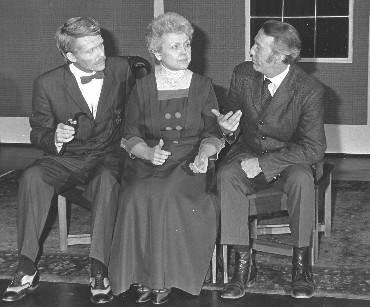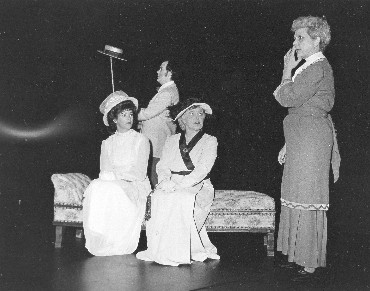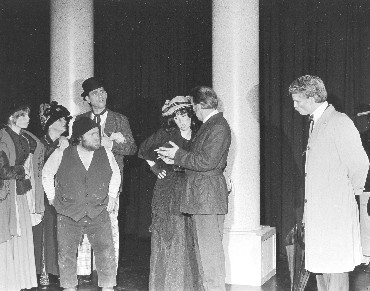Driftwood Players
"Pygmalion"
April - May 1983
By George Bernard Shaw
Directed by Gloria Ingram and Val Pearson

- Cast of Characters: John Wolfe: (Henry
Higgins) Art Blauvelt: (Pickering)
Hank Bilderback: (Doolittle) Lisa
Thompson: (Eliza Doolittle) Margaret
Savas: (Clara Eynesford Hill) Kevin
Carney: (Freddy Eynesford Hill) Val
Pearson: (Mrs. Pearce) Phyllis Shrauger:
(Mrs. Higgins) Carol Stubb: (Mrs.
Eynesford Hill) Darlene Blevins: (Parlor maid)
Bill Garrison: (Bystander) Larry
Beard: (2nd Bystander) Roechelle
Landstrom: (Flower girl) Bryan Harper:
(Taxi Driver) Darlene Blevins: (2nd Flower girl)
|
|
 |
 |
|
|
|
 |
 |
|
|
|
Pictures by
George McCleary
|
From The Daily World Sunday, April 24, 1983
Player's dream now a reality
'Pygmalion' to wind up first season of new
Driftwood theater
- By Betty Butler
- Daily World Writer
After a busy eight months, the Driftwood
Players will open this Friday night the final production of the first season in
their impressive theater at Third and I streets in Aberdeen.
The play is "Pygmalion," famed
playwright George Bernard Shaw's London-1900s version of the Greek legend about
a sculptor who created a beautiful statue and then fell in love with his
creation.
It's an appropriate production for the
Driftwood Players, who two years ago looked at a 50-year-old church too big for
its congregation, and fell in love with what they envisioned as one of the
finest community theaters in the Northwest.
They've done quite a lot of
"sculpting" since in order to create the model theater that they
visualized.
First came the Herculean effort to raise more
than $200,000 with which to purchase the building, build risers and install
seats in the auditorium, enlarge the stage and install $48,000 worth of
electrical lighting and sound systems.
Those projects, plus a lot of paint, brought
them to the opening of the 1982-83 season with a high-spirited production of the
comedy "Auntie Mame."
TWO THREE-ACT plays and two short
children's plays later, the season's fourth production finds the Driftwooders in
vastly improved backstage facilities, but with dreams still to satisfy.
"It's almost uncanny, how well the floor
plan of the church worked into a theater," was a frequent comment last
summer when the church congregation moved out and the theater crews moved in.
There's been no change of opinion since.
"Even the little reading rooms behind
the stage are just right for individual dressing rooms where actors can make
their between-scene changes quickly," Ernie Ingram, director of the
new-theater project, pointed out.
"Look at this gorgeous makeup
room," enthused Hank Bilderback, a long-time performer, member and officer.
He was standing in the long, mirror-lined room where a dozen persons were
applying makeup in the glare of closely-spaced light bulbs edging the
mirrors.
 Even tiny Heather Blauvelt, sitting on her father Art's lap while Gary Morean
applied his rehearsal makeup for the role of Col. Pickering, seemed to
appreciate the bright lights and the space available. The makeup room in the old
Hoquiam theater would never have accommodated her stroller.
Even tiny Heather Blauvelt, sitting on her father Art's lap while Gary Morean
applied his rehearsal makeup for the role of Col. Pickering, seemed to
appreciate the bright lights and the space available. The makeup room in the old
Hoquiam theater would never have accommodated her stroller.
Builders like George Franich especially
enjoyed the carpenter shop that shares the huge theater basement with a newly
walled-off costume loft. In the old theater, many set pieces had to be built on
stage, and moved out of the way of actors during rehearsals.
Now the table saws and other tools can be set
up where needed and can be left there, and carpenters can work while rehearsals
are going on upstairs.
THE THEATER organization has been
accumulating costumes for 22 years -- many given to it when Harbor residents
cleaned out attics or unpacked long-forgotten storage trunks, many others
constructed especially for certain roles. In the old theater, stacks of boxes
were packed with hats , dresses, coats, and wigs, and clothes racks were so
jammed that it was hard to find the needed costumes.
Now the costumes hang in relatively neat rows
in the new quarters, and in small nearby rooms wide shelves hold an assortment
of wigs, hats ranging from 18th century plumed headpieces to chic cloches, and
accessories like above-elbow gloves, lace shawls and silk purses.
Walling off the costume loft cost $1,215; the
makeup room and new green room, once a raised dais above the basement floor and
now a cozy retreat with a sofa and coffee-maker, were converted for $7,537. A
new restroom for handicapped persons cost $2,758, according to a detailed report
that Ingram produced a few days ago for supporters of the theater.
No structural changes were necessary except
the addition of two partitions; the rooms were utilized as they were.
The spacious lobby, with its finely-crafted
1920s woodwork, provides a second rehearsal area when productions
"overlap," as happened when the recent "The Plays the Thing"
was being performed while two children's plays were in rehearsal.
There's just one draw back -- the size of the
utility bills. But despite expenses of keeping the huge building heated for
almost constant use, the Driftwood Theater has managed to finance improvements
and still make payments on its small remaining debt.
The Driftwood Players provide the area's only
purely nonprofit, volunteer community theater, and they have hundreds of loyal
supporters both within the organization and among the theater-going public.
Because of those friends, Ingram could say at
the end of the new theater's first season, "Together I think we have
created one of the finest community theater structures in the United States and
one which we will all have the opportunity of enjoying for years to come."
From The Daily World Wednesday, May 4, 1983
'Pygmalion' shows Shaw's bite
- By Betty Butler
- Daily World Arts Editor
-
Comparisons are inevitable between
"Pygmalion," George Bernard Shaw's classic play now being produced by
the Driftwood Players, and "My Fair Lady," the musical that was
derived from it and produced here several years ago by the Grays Harbor Civic
Choir.
A full-house opening night audience applauded
the Driftwood production heartily last Friday, but seemed a little bemused by
the somewhat ambiguous ending, not the same "they lived happily ever
after" conclusion as the musical.
It was obvious as the play proceeded that the
inclusion of musical numbers and the consequent change in tone of "My Fair
Lady" had meant that many of Shaw's best lines were cut and his biting
comments on "high society" were toned down.
They aren't toned down in the performances of
Lisa Thompson as Eliza Doolittle, the Cockney flower girl; John Wolfe, as
Professor Higgins, who transformed her into a "princess," and Hank
Bilderback, as Eliza's philosophically opportunistic father.
The father's role especially is richer and
less a caricature, masterfully played by Bilderback, in the Driftwood
"Pygmalion."
"Eliza" also comes off better, as
Thompson brings her from a sniveling street peddler to a cultured young woman
with independent ideas that seem more contemporary than Victorian.
Wolfe's "Higgins" is more the
crusty, cynical professor with virtually no romance in his soul -- more
convincing but less appealing than the hero of "My Fair Lady."
Art Blauvelt creates an earnest, stuffy but
compassionate Col. Pickering, the true gentleman, and Val Pearson, as always,
make a standout of her small but important part as Higgins'
far-from-subservient housekeeper.
Phyllis Shrauger does the professor's
upper-class, commonsense mother to perfection, and Carol Stubb with equal skill
plays a weepy, impoverished Mrs. Eynesford Hill, mother to a sharp-tongued
daughter well portrayed by Margaret Savas, and an ineffectual but likeable son
played by Kevin Carney.
Effective in bit parts were Bill Garrison,
Bryan Harper, Larry Beard, Roechelle Landstrom and Darlene Blevins.
Gloria Ingram and Val Pearson were
co-directors, producing a rapier-sharp commentary on the social mores of
Victorian English upper-class life as well as a piece of good entertainment.
The audience enjoyed the between-act shows as
members of the cast changed the versatile scenes from Covent Garden to Prof.
Higgins' speech laboratory to his mother's drawing room and back
again. The sets were designed by Ernie Ingram, and the ingenious furniture was
constructed by John Eko. The authentic looking costumes were assembled by Jeanne
Wolfe.
The Play will show at 8:15 this Friday and
Saturday night, and May 13, 14, 19, 20 and 21. Tickets are at City Drug in
Aberdeen, Harbor Drug in Hoquiam, and Monte Drug in Montesano.
Home
Driftwood Players Inc.




